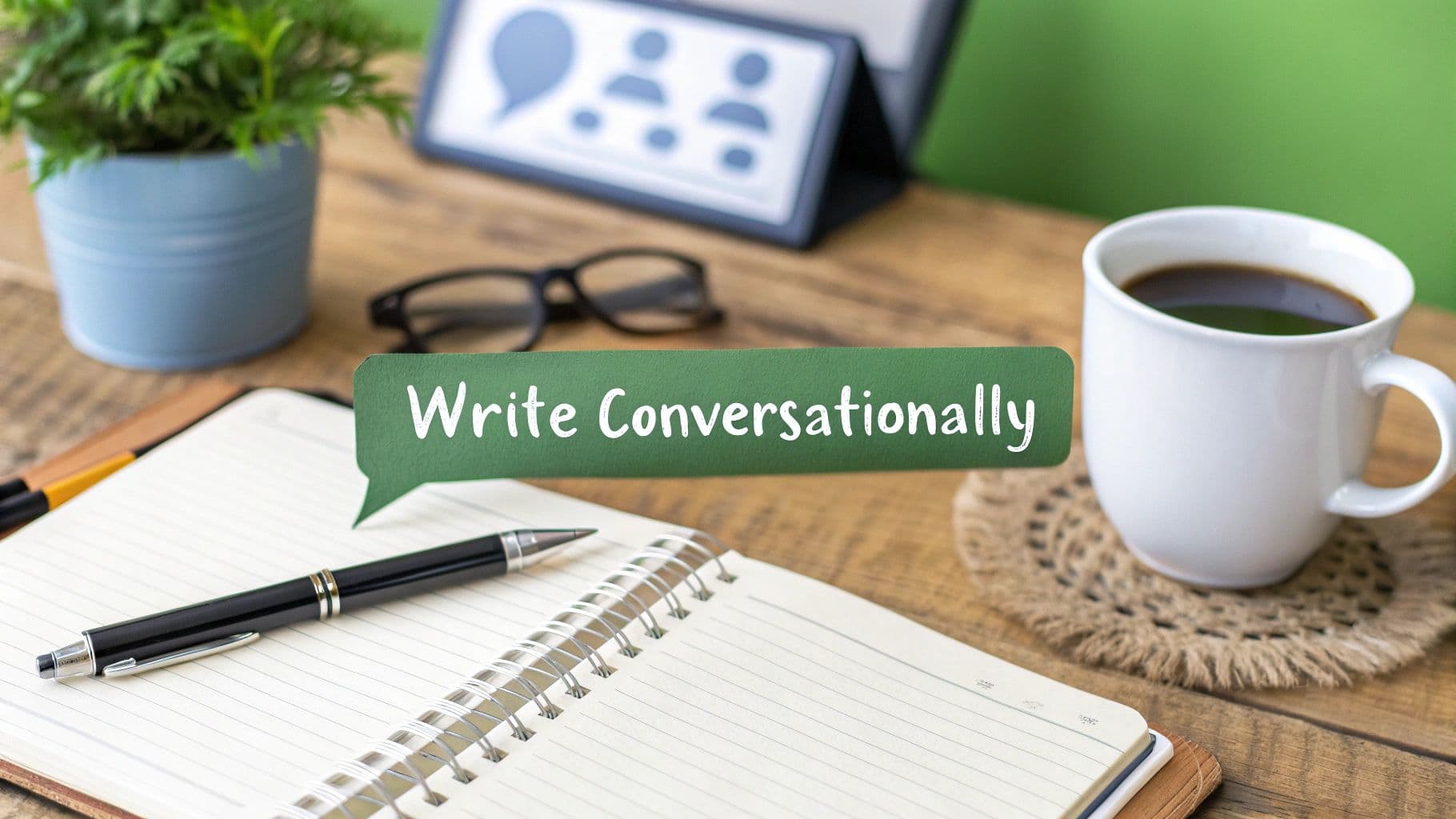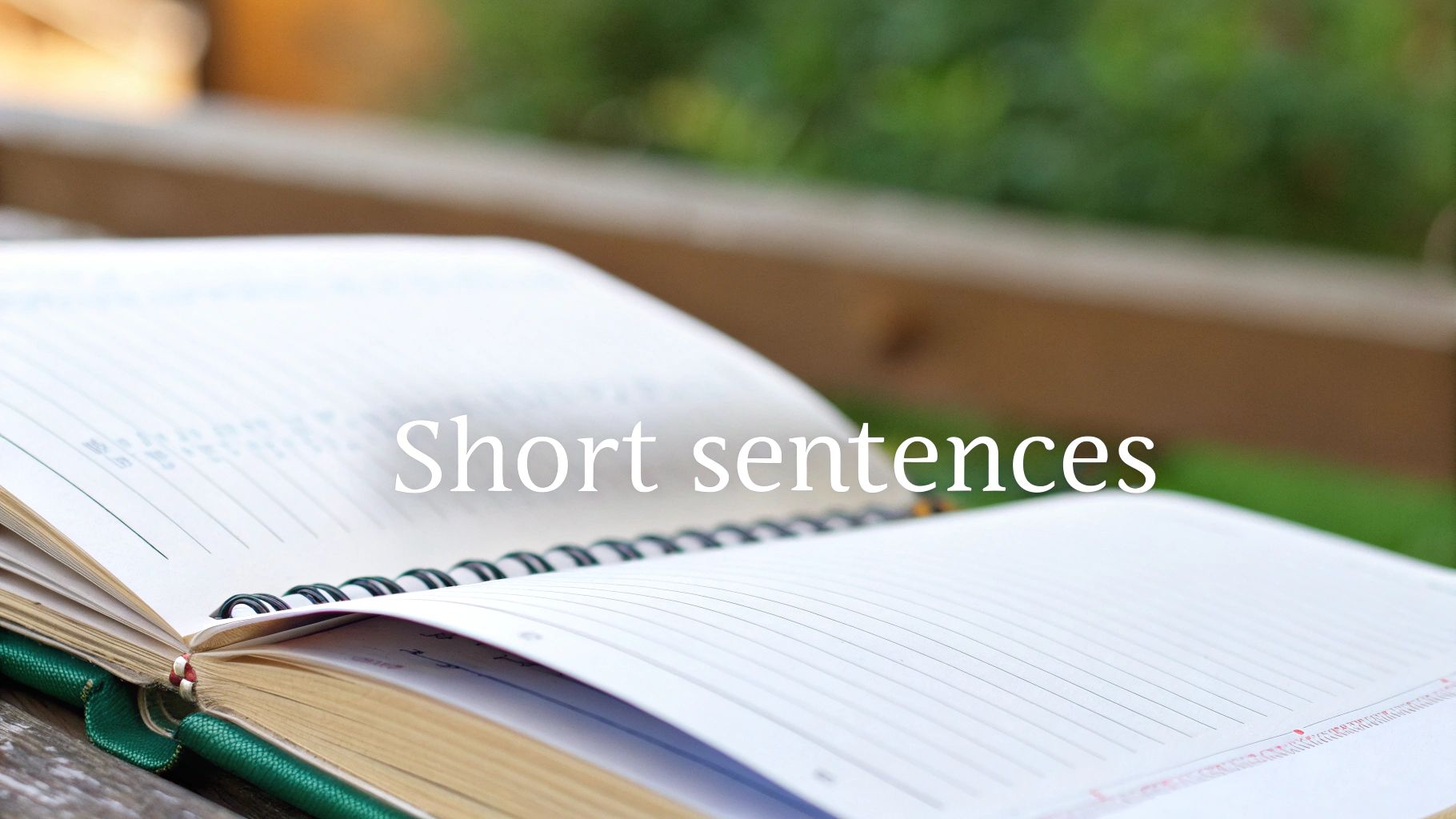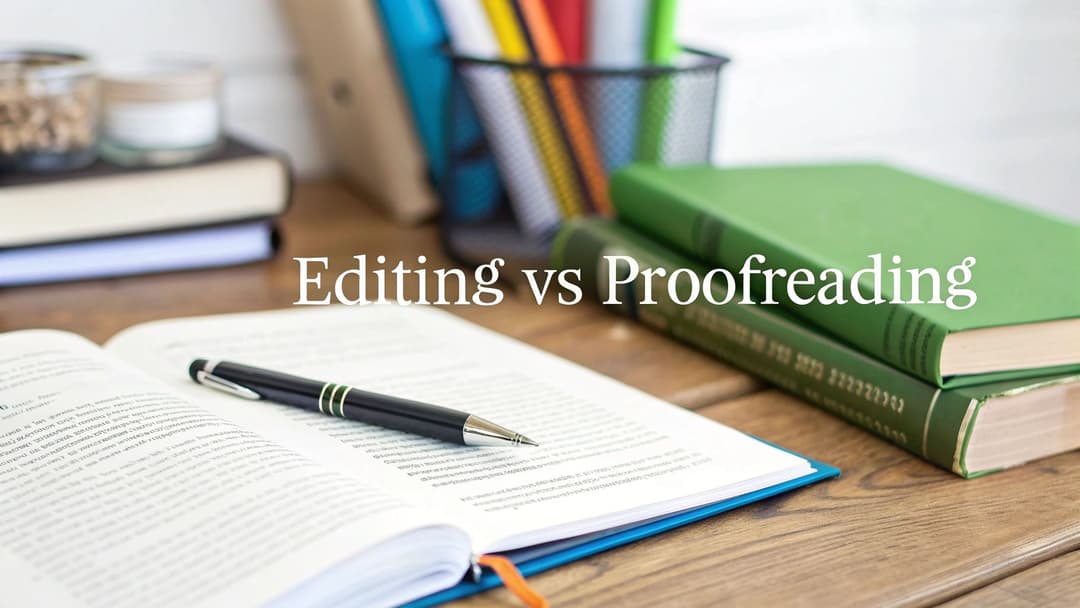
How to Write Conversationally: Tips to Engage Your Audience
July 30, 2025
To make your writing feel conversational, you need to do one simple thing: write the way you talk. It’s about ditching the stiff, academic tone and instead, creating a genuine connection with the person reading your words. You're not being unprofessional; you're being human.
What Is Conversational Writing and Why Does It Matter?
Let's clear something up right away. Conversational writing isn't about being sloppy or lazy. It’s about being clear, relatable, and authentic.
Think of it as the difference between giving a formal lecture from a podium and having a helpful chat with a friend over coffee. You’re not "writing for a faceless audience"; you're "talking with a real person." This style is so effective because it taps into the very core of how we build trust. When your writing sounds like a real person, it feels more genuine and approachable.
This isn’t just a stylistic choice—it’s a strategic one. It makes complex information much easier to digest and far more memorable.
The Power of Connecting With Your Reader
Formal, academic-style writing puts up a wall between you and your reader. It can feel intimidating and, let's be honest, pretty boring. Conversational prose, on the other hand, tears that wall down.
By using "you," asking questions, and sharing small asides, you pull the reader right into the content. They become an active participant instead of a passive observer just scanning the page.
The data backs this up, too. Just look at the impact of switching from a formal to a conversational tone on key engagement metrics.

As you can see, the shift dramatically improves readability, which translates directly to more time on page and better user engagement. It just works.
Why It Works So Well Online
People online are scanners. They’re jumping from tab to tab, looking for quick answers and clear information. Studies show that web users typically read only about 20-28% of the words on a page. That's not a lot.
But they do engage more deeply with content that uses simple, direct language.
Conversational writing respects the reader's time. It gets straight to the point without bogging them down with unnecessary jargon or convoluted sentences. It makes your message more accessible, ensuring everyone can understand what you're trying to say.
To quickly see the key differences, check out this table. It breaks down the core concepts so you can start applying them right away.
Formal vs Conversational Writing At a Glance
| Element | Formal Writing Approach | Conversational Writing Approach |
|---|---|---|
| Tone | Objective, authoritative, impersonal | Friendly, approachable, personal |
| Pronouns | Uses third-person (he, she, they) | Uses first and second-person (I, we, you) |
| Language | Complex vocabulary, technical jargon | Simple, everyday words, plain language |
| Sentences | Long, complex structures | Short, direct sentences, varied lengths |
| Contractions | Avoided (do not, it is) | Used naturally (don't, it's) |
| Questions | Avoided; statements are preferred | Used often to engage the reader |
| Goal | To inform or instruct authoritatively | To connect, help, and persuade |
This comparison really highlights the shift in mindset. It's less about sounding "smart" and more about being understood.
Ultimately, knowing how to write conversationally is a critical part of developing strong, effective written communication skills. It’s the secret to keeping readers on your page longer, building a loyal following, and making your message actually stick.
Find Your Authentic Conversational Voice

Here’s the secret to great conversational writing: it’s not about faking it. It’s about finding a voice that’s genuinely yours. Your writing should sound like you, not some generic template or, worse, a robot. Authenticity is what forges a real connection with readers, making them feel like they’re getting advice from an actual person.
This is where a lot of writers get tripped up. They try so hard to sound "conversational" that the writing ends up feeling forced and awkward. The goal is to land on a voice that feels both uniquely you and true to your brand. It’s a balancing act, but it’s easier to strike than you might think.
If you want to see how different brands pull this off, check out these unforgettable brand voice examples. You’ll see just how much personality can shine through.
The Ultimate Litmus Test: Read It Out Loud
I’m going to share a practical tip that works every single time: read your writing out loud. Seriously. It’s the simplest, most powerful way to check if your content flows naturally.
If you find yourself stumbling over words, running out of breath, or just feeling a bit silly saying a sentence, that’s a massive red flag. Your ears will catch the awkward phrasing and clunky sentences that your eyes glide right over.
To help close the gap between how you think and how you write, some people have found success by just speaking their content first. In fact, utilizing dictation software to find your natural writing voice can be a fantastic way to capture your genuine conversational style as you speak it.
Quick Fixes for a More Natural Tone
So, what if your "read-aloud" test reveals some stiff, robotic sentences? Don't worry. Here are a few immediate tweaks you can make to sound more human.
Use Contractions. When we talk, we use them all the time. We say "it's" instead of "it is," and "you're" instead of "you are." Sprinkling these into your writing is an instant way to make it feel more relaxed and approachable.
Talk Directly to Your Reader. Use the word "you." It’s incredibly powerful. Writing in the second person pulls your reader right into the conversation, making them the main character. The focus shifts from "Here is some information" to "Here is how this can help you."
Let's see this in action.
Before (Stiff & Formal): It is imperative that all users complete the required fields prior to submission. The platform will not process incomplete forms.
After (Warm & Conversational): Just make sure you fill out all the fields before hitting submit. It’s the only way the platform can process your form!
The "after" version is clearer, friendlier, and much more likely to be read and understood. It just feels more relatable.
And this isn’t just a matter of style—it gets results. A major survey found that 72% of consumers preferred brands that communicate with a conversational tone, describing them as more trustworthy. This preference even led to a 25% average improvement in conversion rates when posts used conversational language. Injecting your personality doesn't just sound good; it works.
Actionable Techniques for Conversational Writing
Knowing why you should write like you talk is the easy part. Figuring out how to actually do it? That's a different story. So, let's move past the theory and get our hands dirty with some practical techniques you can start using today to make your writing feel more human.
Think of this as your toolbox for building prose that genuinely connects with people. The idea isn't to follow some rigid formula, but to absorb these methods until they become second nature. You're building a bridge to your reader, one simple move at a time.
Ditch the Jargon and Keep It Simple
How do you explain something to a friend over coffee? You probably don't pull out stiff, overly academic words. You use simple, everyday language to get your point across. This is one of the fastest ways to make your writing more conversational.
Go through your draft and hunt down any complex words that have a simpler alternative. This isn't about "dumbing down" your content; it's about making it accessible and easy to understand.
Here’s a quick before-and-after:
| Instead of This... | Try This... |
|---|---|
| Utilize | Use |
| Furthermore | Also |
| Subsequently | Later |
| Demonstrate | Show |
| Inquire | Ask |
See how that small shift makes everything feel more direct? Clear communication builds trust, plain and simple. For a deeper dive, we cover more on this in our guide on essential tips for clear writing.
Use Questions to Create a Dialogue
Ever notice how a great conversation is a two-way street? You can create that same back-and-forth feeling in your writing just by asking questions.
Questions stop readers in their tracks. They break up the passive experience of just scanning text and invite them to pause, think, and engage with what you're saying.
You can sprinkle in questions like:
- "But how does this actually work in practice?"
- "Sound familiar?"
- "What would you do in this situation?"
This one little trick can transform a monologue into a dialogue, making your reader feel like they're part of the conversation.
Key Takeaway: Asking questions is a powerful tool for learning how to write conversationally. It pulls your reader into the topic, making them feel seen and involved.
Keep Your Paragraphs Short and Scannable
Nobody wants to face a massive wall of text. It's intimidating, especially on a screen, and it’s a surefire way to make readers click away.
Keep your paragraphs short. Aim for just one to three sentences each. This creates much-needed white space, making your content feel breezy and easy to scan. Think of each paragraph as a single, complete thought.
This approach also mimics the natural rhythm of a real conversation. We talk in short bursts, not long, unbroken speeches. Your writing should reflect that. Of course, becoming a better conversational writer is part of a bigger picture. To round out your skills, check out these 10 proven ways to improve writing skills.
Weave in Personal Stories and Anecdotes
Facts and data are great, but stories are what make them stick. Sharing a quick personal story, a relevant anecdote, or a real-world example makes your writing instantly more relatable.
You don't have to pour your heart out. It can be as simple as:
- "I used to struggle with this constantly until I discovered..."
- "A client once asked me a great question that really made me think..."
- "I still remember the first time I tried to..."
These little glimpses of humanity show you're more than just an anonymous voice online—you're a real person. It proves to your reader that you get their struggles because you've been there, too. That's how you build an authentic connection that generic, faceless content never will.
How to Structure Your Content for a Natural Flow

A great conversation doesn't just jump around randomly. It flows, with one idea building logically on the last. Your writing should feel the same way. The secret to writing conversationally isn't just about the words you choose—it's about how you organize them on the page.
Think of good structure as the invisible architecture of your article. It’s what guides your reader through your thoughts without them ever feeling lost or confused. Without it, even the most brilliant ideas can come across as a jumbled, frustrating mess.
Use Subheadings as Friendly Signposts
I like to think of an article as a journey. Your H2s and H3s are the signposts along the path, telling your reader where they are and what’s coming up next. They’re essential for breaking up long walls of text and making your content instantly scannable.
Let’s be real—most people don't read every word. Someone landing on your page should be able to get the gist just by scanning your subheadings. This approach makes your content feel less like a dense textbook and more like a helpful, organized chat.
For instance, instead of one massive section, break it down with clear, action-oriented H3s. Each one should promise a specific benefit or answer a specific question. It’s a simple trick that respects your reader's time and keeps them scrolling.
Build Your Argument Step-by-Step
A natural conversation builds momentum. You don't just drop your most complex point out of nowhere. You start by setting the scene, establishing a foundation, and then layering new ideas on top. Your content needs to follow that same logical progression.
Start with a broad concept or a common problem your reader already understands. Once you've hooked them with something relatable, you can start digging into the more specific details, examples, and solutions.
My two cents: Always structure your content to move from the general to the specific. Each paragraph should feel like it's pushing the main idea forward, carrying the reader along without any jarring stops or confusing detours.
This method creates a logical flow that just feels right, making your argument more persuasive and a whole lot easier to follow.
The Pre-Publish Structure Check
Before you hit publish, do a quick structural review. I promise, this final polish can make a massive difference in how your content is received. It's the last step in turning a good draft into a great reading experience.
Just run through these questions:
- Is it scannable? Can someone grasp the core message just by glancing at the headings, bolded text, and lists?
- Are there visual breaks? Have you used short paragraphs, bullet points, or blockquotes to avoid that dreaded wall-of-text look?
- Does it actually flow? Does each section connect logically to the one before it, or did you accidentally jump from one idea to another?
- Are the transitions smooth? Are you using little bridge phrases like "That said..." or "On the flip side..." to guide the reader between different points?
By focusing on these structural elements, you're not just organizing words—you're crafting a better experience. You’re making your content more inviting, easier to digest, and ultimately, far more effective.
Editing Your Writing to Sound More Human
The final polish is where your writing really comes alive. Drafting gets your ideas on the page, but editing is where you find your human voice. It's the last, and most important, step in learning how to write conversationally—turning a decent draft into something that genuinely connects with people.
This part of the process is less about strict grammar rules and more about feel. Does it sound like something a real person would say out loud? Or does it read like it was pieced together by a machine?
There's a simple trick to find out: read your writing aloud. Seriously. It’s the most powerful editing tool you have. It instantly reveals clunky sentences and robotic phrasing that your eyes might have skimmed right over. If you stumble, feel awkward, or find yourself running out of breath, that's your signal to revise. It's a foolproof way to catch anything that kills the natural rhythm of speech.
A Practical Self-Editing Checklist
Think of this editing phase as a friendly audit. You're not hunting for mistakes to punish yourself over; you're looking for opportunities to make your writing clearer, warmer, and more engaging.
Your goal here is to refine, not rewrite everything from the ground up. Even in more formal writing, a human touch makes a world of difference. You might not use contractions in an academic paper, for example, but the core principles of clarity and flow still apply. The same detailed eye you'd use when you edit a research paper to improve its clarity is what you need here, just with a different voice in mind.
Here’s a quick checklist to guide you:
- Cut the Fluff: Are there any "filler" words you can chop? Phrases like "in order to," "the fact that," or "it is important to note that" just add clutter. Be ruthless.
- Swap Jargon for Simplicity: Did you use a complicated word when a simple one would work just as well? Ditch "utilize" for "use," "subsequently" for "later," and "facilitate" for "help."
- Check Your Tone: Is your voice consistent? Read through and make sure you don't suddenly switch from friendly and helpful to stiff and corporate.
- Look for Contractions: Have you used words like "it's," "you're," and "don't"? If not, sprinkling them in is one of the fastest ways to sound more natural and conversational.
This isn’t just a stylistic choice. It reflects a major shift in how we communicate online.
With the explosion of conversational AI—now used by nearly 987 million people—readers have come to expect content that feels immediate and personal. This trend points to a clear preference for more accessible, human communication online. You can read the full statshot report from We Are Social to learn more about these digital habits.
Using Tools as a Guide, Not a Rulebook
Readability tools like the Flesch-Kincaid test can be fantastic guides. They’re great at flagging sentences that are too long or words that are overly complex, giving you a data-driven peek at how accessible your writing is.
But remember to treat these tools like a helpful GPS, not a strict drill sergeant. A low readability score is a good reason to take a closer look, but don’t start sacrificing your unique personality just to please an algorithm.
Ultimately, the goal is to create writing that is clear, engaging, and authentically you. Use the tools to spot potential friction points, then trust your gut—and your ear—to make the final call. That's the real secret to editing that enhances your human voice instead of erasing it.
Common Questions About Conversational Writing

Switching to a more relaxed writing style can feel a bit weird at first. I get it. If you’ve spent years writing in a formal or academic way, letting go of those rules is bound to bring up a few questions.
So, let's go through some of the most common worries writers have when they start writing conversationally. My goal here is to clear up any doubts so you can start writing with confidence, knowing you’re actually connecting with your reader.
Can I Still Sound Professional?
Of course. This is probably the biggest myth out there about conversational writing.
Being conversational isn't about being sloppy or unprofessional. It's about being clear and relatable. Think of it like this: would you rather listen to a dry, monotone lecture or an engaging TED Talk? Both are delivered by experts and are totally professional, but one is way better at grabbing—and keeping—your attention.
Professionalism comes from the value and accuracy of your information, not from using complex sentences or a distant tone. A conversational approach makes your expertise more accessible, which actually builds more trust and authority.
You want to be the expert who’s also approachable and easy to understand.
Does This Style Work in Every Industry?
While the degree of formality might shift, the core ideas of conversational writing—clarity, directness, and putting the reader first—are gold in any field. You just have to adapt the techniques to fit the context.
For example, in super-regulated or technical industries like law, finance, or medicine, you’ll probably want to skip the slang and use fewer contractions. But you can still:
- Address the reader as "you" to make the content feel personal and relevant.
- Use the active voice to keep your sentences direct and punchy.
- Break down complex ideas into simpler, more digestible pieces.
- Keep paragraphs short so they’re easy to read on a screen.
At its heart, conversational writing is just effective communication. That goal is universal, even if the tactics change slightly from one industry to the next.
How Do I Avoid Sounding Too Casual?
Finding that perfect balance comes down to one thing: knowing your audience.
The conversational style you’d use for a blog post aimed at Gen Z gamers is completely different from one you’d write for corporate executives. The trick is to imagine you're explaining something to a smart colleague you respect.
This simple mental shift keeps the tone friendly and focused, but also professional and clear. It stops you from getting too familiar while making sure your writing still sounds human.
Always start by picturing who you’re talking to.


